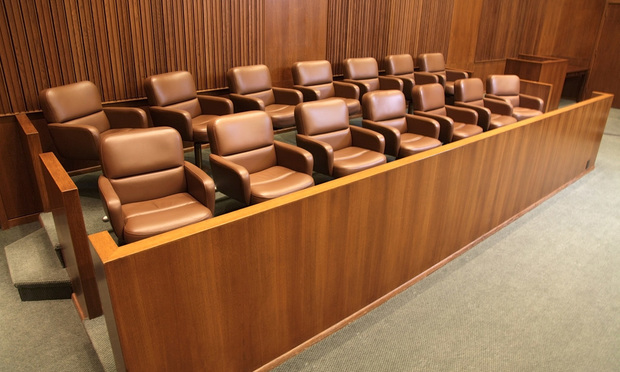Helping Juries Succeed
Juries do get the facts, and they do work hard, but we are collectively failing juries by not giving them simple comprehensible instructions.
December 18, 2017 at 08:20 AM
9 minute read

Although juries are often criticized for reaching irrational decisions, multiple studies from jury consultants, sociologists and psychologists find that juries excel at observing and understanding the facts. The jurors see everything in the courtroom because they have nothing else to do but observe the scene before them. So why are juries criticized—as in the O.J. Simpson case—for errant decisions? Capable trial lawyers and judges can honestly disagree over the competence of juries. Judge Jack Weinstein reportedly believes juries are wonderful and intelligent. Many experienced trial lawyers and judges are not so convinced. Although I cannot resolve the great debates of whether juries are good or bad, the purpose of this article is to address: (1) some conceptions and misconceptions about juries; (2) what studies show juries are good at; and (3) where lawyers and judges fail, and how they can work better.
Conceptions and Misconceptions About Juries
Defense counsel are typically leery of juries, and fear that juries are irrational bloodthirsty mobs aching to give money away to plaintiffs. The press feeds this fear and loves to run stories of fantastic jury awards and what, from a distance, appear to be questionable jury decisions. Although runaway juries are always a legitimate concern to defense counsel, a number of studies have found that plaintiffs have a less than 50-50 chance before a jury. Neil Vidmar, “Are Juries Competent to Decide Liability in Tort Cases Involving Scientific/Medical Issues? Some Data from Medical Malpractice,” 43 Emory L.J. 885, 902 (1994).
Are juries irrational? Actually, they are excellent at observing the facts and listening to the testimony. Juries get the facts. Where they often come up short is in applying the law. Juries see and hear everything. Perhaps because for many jurors this is their first personal exposure to the court system, jurors tend to work really hard at their job of observing the witness, studying the exhibits and listening to arguments as well as the court's instructions. Jurors work hard. This hyper-attentiveness comes at some risk of which trial counsel and the court should be aware—the jury is looking at everything going on in the courtroom. What exhibits are just lying around so the jury can see? What visible exhibits are on the floor of the court or behind counsel's desk? Did the trial judge or counsel roll their eyes or wince when certain testimony was elicited? The jury sees everything, and they will discuss it, despite the trial judge's strict instructions that they are not to do so until the matter is submitted to them for deliberation. The only issue these jurors have in common is this trial—so what else are they going to talk about?
We Fail Juries for a Very Simple Reason: Jury Instructions Are Tedious, Boring and Incomprehensible
I have no doubt this statement will draw some criticism, but repeated studies show that jurors get the facts and try really hard. Where jurors often fail is on applying the law. It is not productive to blame either counsel or the court system for this failure, nor is it my intent. By the end of trial, when counsel are putting the finishing touches upon jury instructions, both trial counsel and perhaps the court are exhausted with closing arguments and negotiations over jury instructions. There is an understandable temptation to just use the standard jury charges. That is a huge mistake because juries just do not understand the standard instructions. Christopher N. May, “'What Do We Do Now?': Helping Juries Apply the Instructions,” 28 Loyola L. Rev. 869, 872 n.14 (1995).
Several studies indicate that: (1) jurors' understanding of the instructions is little better than if they had received no instructions at all; and (2) the ability to understand the instructions correlates, to some degree, to a juror's degree of education. In a study of 631 jurors using a 30-minute videotape and questionnaire that explained the law, only 51 percent properly applied the law. Twenty-eight percent were unclear, and another 21 percent were simply wrong. Bradley Saxton, “How Well Do Jurors Understand Jury Instructions? A Field Test Using Real Juries and Real Trials in Wyoming,” 33 U.Wy. Land and Water Review 1, 69 (1998). Another study, by Alan Reifman, “Real Juror's Understanding of the Law in Real Cases,” 16 Law and Hum. Behav. 539 (1992), similarly finds that—using standard jury instructions—juries understand about half of the instructions they are given.
In addition to failing to understand the standard jury instructions, juries often fail at estimating risk but, paradoxically, are usually unfairly critical of manufacturers that engage in risk-benefit analysis if safety is the issue in question. Jurors also tend to react negatively to a corporate defendant calculating risk as a factor into safety design, because there is a primal instinct that the product should be as safe as possible. The problem inherent in this analysis is that corporations engaging in cost-benefit analysis are not insensitive money grubbing institutions, rather, they are engaging in exactly the same trade-off analysis we each engage in every day. (Should I take the back road that has less traffic but takes longer, or should I take the highway, which is faster but more dangerous? Should I buy the cheaper generic drug, which is slightly less efficacious, or the name brand that is much more expensive and works better?)
What Can we do to Help Juries Succeed?
Making jury instructions easily digestible is difficult. The trial court is necessarily concerned about the risk of appeal if it deviates from the standard jury instruction. Counsel are also concerned about stepping on the judge's toes by discussing the law with the jury because it is the province of the court to instruct the jury on the law.
This is an area where trial counsel can better serve their clients and the jury by discussing with their adversary and the trial court the need to orientate the jury on the law from the outset so that the jury knows what to look for during the course of trial. Too often trial counsel provide only the most general overview of their case during opening statements and steer clear of stating the law. As a result, the jury has some vague idea of what the case is about but has no clue what to look for during the course of trial.
A few solutions to this dilemma include the following:
- A canned video on orientation to jury service should be shown during voir dire. First, jury duty is dull because we show up and sit—we might as well learn something. Second, this will educate the jury in a neutral fashion.
- Discuss the elements of what you intend to prove during opening without arguing. You are allowed to inform the jury in a general way about your theory of the case and what facts you intend to prove. It may behoove trial counsel to make sure the jury knows what to look for during the trial—but also to avoid arguing, as this will draw an objection. Without a frame of reference for the evidence that is to come, a juror observing a trial is in essence watching a foreign movie without subtitles. Fred H. Cate, “Communicating with Juries,” 68 Indiana L.J. 1101 (1993). Opening statements are not to do more than inform the jury in a general way of the action and basic facts so that the jury is prepared to understand the evidence—perhaps we want to avoid argument but also give the jurors a little more direction. Passaic Val. Sewerage Com'rs v. Geo. M. Brewster & Son, 32 N.J. 595 (1960). Trial counsel need to weave the jury instructions into their openings, use the language of jury instructions during the course of the case, and certainly must discuss the jury instructions during closing arguments. A few other cautions: (a) avoid legal jargon; (b) juries are confused over the concept of legal evidence; and (c) communicate using the language of the jury charges throughout the case, not merely at the end.
- Tell a story. Juries, like rest of us, love stories. Work on converting your case into a story that the jury can test the validity of during the course of the trial. They will remember, and understand, a story. And if the elements of your case, and the facts, can be converted into an appropriate story line, the jury will be interested and able to remember what to look for during the course of trial.
- Anchors away! Consider giving the jury an anchor so that they have a target to focus on. Even if you're defense counsel and believe that the matter should be dismissed, consider giving the jury some low target value to help guide them to that number, as otherwise they may choose a much higher number of their own (or the converse, if I am asking for money, I tell them right up front what number I want and let them know I will repeat it at the closing.)
- Consider not using the standard jury instruction, and let the trial court actually talk with the jury. Although there is no doubt some risk that the trial court may misstate a standard, a plain language discussion with the jury will help them really understand their job. Doubtless, both lawyers and the court may be concerned about this approach but the entire discussion with the jury is recorded, so the worst that happens is that: (1) the jury actually understands the instructions, or (2) there is a risk of mistrial because the court inadvertently makes a misstatement. Is that risk worse than having the jury not understand the instructions at all? This is something that trial counsel and the courts need to consider.
Conclusion
The best conclusion is that juries do get the facts, and they do work hard, but we are collectively failing juries by not giving them simple comprehensible instructions. I am proposing that both the trial judge and legal counsel have a duty to work just as hard as the jurors to develop jury instructions that are comprehensible.
Pollock is a partner with Fox Rothschild in Princeton. He focuses his practice on complex litigation and appellate practice.
This content has been archived. It is available through our partners, LexisNexis® and Bloomberg Law.
To view this content, please continue to their sites.
Not a Lexis Subscriber?
Subscribe Now
Not a Bloomberg Law Subscriber?
Subscribe Now
NOT FOR REPRINT
© 2025 ALM Global, LLC, All Rights Reserved. Request academic re-use from www.copyright.com. All other uses, submit a request to [email protected]. For more information visit Asset & Logo Licensing.
You Might Like
View All
Johnson & Johnson Must Pay $1B in Damages for Surgical Robotics Contract Breaches, Fraud
4 minute read
Law.com Radar Boosts State Court Alerting With SALI Claim Labels

NJ-Based Pharma Co. Asks Del. Supreme Court for Reframed Analysis in Advance Notice Bylaw Dispute
4 minute read
Why DOJ Chose NJ: Prior Cases Sway Choice of Venue in Apple Case, Antitrust Experts Say
3 minute readTrending Stories
Who Got The Work
J. Brugh Lower of Gibbons has entered an appearance for industrial equipment supplier Devco Corporation in a pending trademark infringement lawsuit. The suit, accusing the defendant of selling knock-off Graco products, was filed Dec. 18 in New Jersey District Court by Rivkin Radler on behalf of Graco Inc. and Graco Minnesota. The case, assigned to U.S. District Judge Zahid N. Quraishi, is 3:24-cv-11294, Graco Inc. et al v. Devco Corporation.
Who Got The Work
Rebecca Maller-Stein and Kent A. Yalowitz of Arnold & Porter Kaye Scholer have entered their appearances for Hanaco Venture Capital and its executives, Lior Prosor and David Frankel, in a pending securities lawsuit. The action, filed on Dec. 24 in New York Southern District Court by Zell, Aron & Co. on behalf of Goldeneye Advisors, accuses the defendants of negligently and fraudulently managing the plaintiff's $1 million investment. The case, assigned to U.S. District Judge Vernon S. Broderick, is 1:24-cv-09918, Goldeneye Advisors, LLC v. Hanaco Venture Capital, Ltd. et al.
Who Got The Work
Attorneys from A&O Shearman has stepped in as defense counsel for Toronto-Dominion Bank and other defendants in a pending securities class action. The suit, filed Dec. 11 in New York Southern District Court by Bleichmar Fonti & Auld, accuses the defendants of concealing the bank's 'pervasive' deficiencies in regards to its compliance with the Bank Secrecy Act and the quality of its anti-money laundering controls. The case, assigned to U.S. District Judge Arun Subramanian, is 1:24-cv-09445, Gonzalez v. The Toronto-Dominion Bank et al.
Who Got The Work
Crown Castle International, a Pennsylvania company providing shared communications infrastructure, has turned to Luke D. Wolf of Gordon Rees Scully Mansukhani to fend off a pending breach-of-contract lawsuit. The court action, filed Nov. 25 in Michigan Eastern District Court by Hooper Hathaway PC on behalf of The Town Residences LLC, accuses Crown Castle of failing to transfer approximately $30,000 in utility payments from T-Mobile in breach of a roof-top lease and assignment agreement. The case, assigned to U.S. District Judge Susan K. Declercq, is 2:24-cv-13131, The Town Residences LLC v. T-Mobile US, Inc. et al.
Who Got The Work
Wilfred P. Coronato and Daniel M. Schwartz of McCarter & English have stepped in as defense counsel to Electrolux Home Products Inc. in a pending product liability lawsuit. The court action, filed Nov. 26 in New York Eastern District Court by Poulos Lopiccolo PC and Nagel Rice LLP on behalf of David Stern, alleges that the defendant's refrigerators’ drawers and shelving repeatedly break and fall apart within months after purchase. The case, assigned to U.S. District Judge Joan M. Azrack, is 2:24-cv-08204, Stern v. Electrolux Home Products, Inc.
Featured Firms
Law Offices of Gary Martin Hays & Associates, P.C.
(470) 294-1674
Law Offices of Mark E. Salomone
(857) 444-6468
Smith & Hassler
(713) 739-1250






